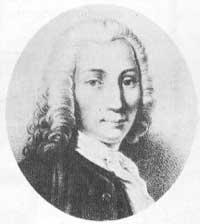Celsius, Anders
1995/08/02 Azkune Mendia, Iñaki - Elhuyar Fundazioa | Kaltzada, Pili - Elhuyar Zientziaren Komunikazioa
(1701-1744)
Swedish astronomer and physicist born in Uppsala on 27 November 1701. His family had a fondness for science, as his father and grandfather were mathematicians and his botanical uncles.

Between 1716-1733 he devoted himself to the study of the northern lights and in 1733 he published 316 observations (made by him and others). The aurora borealis is a luminous phenomenon visible in the north pole (in the south pole are southern auroras). This phenomenon occurs when ionized particles from outer space enter the atmosphere attracted by the magnetic poles of the Earth. Gassendi was the first time he scientifically described this phenomenon in 1621 and since then Halley, Cavendish, etc.
But we come to Celsius. In 1730 he was Chair of Astronomy at the University of Uppsala. There he worked and proposed to measure a degree of meridian in Lapland, participating in the French expedition that took place in 1737, led by Maupertius. In that measurement of the meridian degree, Newton's theory was verified that the Earth was somewhat compressed in the pole.
The same year, in 1730, he conquered the chair of the University, that is, he published Dissertatio de Nova Methodo Distantiam Solis a Terra Determinandi (on the New Method of Calculating the Distance from the Sun to the Earth) and in 1738 he published De Observationibus pro Figure Telluquiris Determinanda Gallia Habitis definition,
In 1740 he built a large astronomical observatory with his laboratories at the University of Uppsala. At that observatory they began to compare the brightness of the stars. We also analyzed the daytime variation of magnetic decline and disturbances produced by the northern lights.
In 1742, at the Swedish Academy of Sciences he read a report describing the thermometer invented by him. Celsius proposed the new temperature scale that was the greatest contribution to science. He took the freezing point of the water and the boiling point as the end of the scale and divided the stretch into one hundred equal parts.
He first applied 100 degrees to the freezing point of water and zero degrees to the boiling point, but the following year he decided to reverse the numbers, zero degrees to the freezing point and 100 degrees to the boiling point. The scale was censored or "one hundred steps" and was used by scientists around the world after Jute.
In 1948 it was decided to call Celsius scale and to say Celsius degree means many times temperatures, but do not forget that the expression degree Celsius is still very used. ºC is its symbol.
In addition to the Celsius scale, there are two others to measure the temperature. One is that of Kelvin (symbol K is used) and measures the absolute temperature. It can be passed from one scale to another using the formula Tc = Ta - 273,15.
The Fahrenheit scale (ºF) is also used to measure temperatures. Especially in America. To move from the Celsius to the Fahrenheit scale, the following equation is used: C = 5/9 (°F - 32).
Anders Celsius died young working at the University of Uppsala observatory. It occurred on November 27, 1744.

Gai honi buruzko eduki gehiago
Elhuyarrek garatutako teknologia





